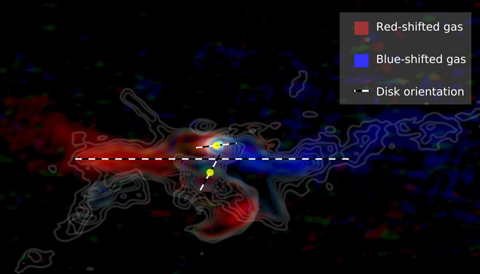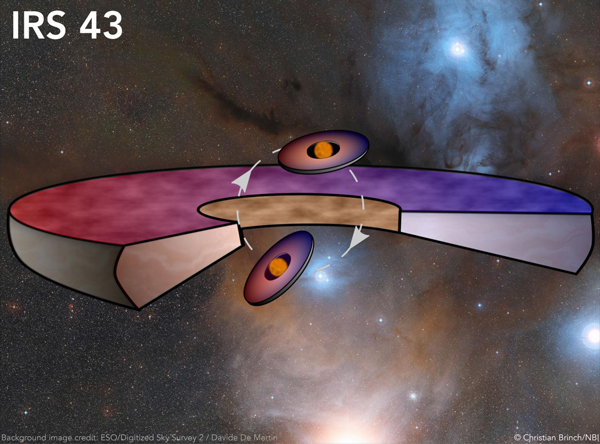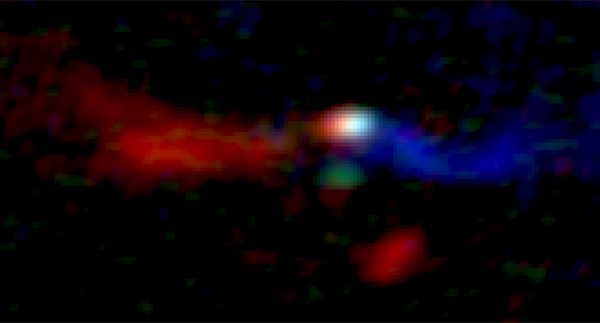A young pair of stars hosts three potentially planet-forming disks, and all three of them are wildly tilted with respect to each other.

Christian Brinch / NBI / KU
Any student of the night sky can see the ancient echo of the solar system’s formation in the ecliptic, the imaginary line along the sky on which the planets dance from night to night. The ecliptic exists because, as the cloud that formed our Sun collapsed into a star, the gas and dust around the glowing core spun into a disk, as though a celestial pizza maker were tossing a ball of dough. So all eight planets formed on a single plane, orbiting the Sun in the same direction that the Sun itself is spinning.
Things usually work the same way around other stars, even binary ones. The Kepler spacecraft has found nearly 100 exoplanets in binary systems, and all of them have been aligned not just with the stars’ rotation but also with the stars’ orbit around each other.
But not all systems are quite so orderly: Christian Brinch (University of Copenhagen, Denmark) and others have now discovered three different planet-forming disks around the binary protostar IRS 43, all akimbo to each other. This newfound chaos may reveal the secret of how binary exoplanet systems form.
And Now for Something Completely Different
Astronomers already knew of the IRS 43 binary from its radio emissions, having observed it for more than a decade using the Very Large Array. It’s a young system in the Rho Ophiuchus star-forming complex, so young that it’s still shrouded in dust and gas — that’s why astronomers must observe it at longer wavelengths that can penetrate the veil. The young stars are currently both about the mass of the Sun (they’re still growing) and only 100,000-some years old. They haven’t yet ignited nuclear fusion in their cores.
Astronomers also knew that a gaseous disk about 700 astronomical units (a.u.) across encircled both stars. Now, a recent study of Atacama Large Millimeter/submillimeter Array (ALMA) observations show that these protostars host not one but three protoplanetary disks — one around each star and one around the pair combined. And each one spins in a different plane than the other two (see below).

Christian Brinch / NBI / KU
Brinch and colleagues focused on gas in these disks, which emits light at specific wavelengths. Observing at these wavelengths, Brinch’s team could determine whether gas was moving toward or away from them by its Doppler shift, where motion away from Earth shifts light to redder wavelengths and motion toward Earth shifts light to shorter, bluer wavelengths. In an edge-on disk that spins around a protostar, you’d see gas on the receding side appear redder and the approaching side bluer.
By mapping out the Doppler shift of all the softly glowing gas in the system, Brinch’s team could calculate the angle of each disk.
The new images’ unprecedented clarity revealed that “the three planet-forming discs are almost ‘tumbling around’ and are skewed relative to each other,” explains Brinch. “It is quite bizarre.”
Born This Way

Christian Brinch / NBI / KU
The question remains, why is this system so messy, and so unlike other planetary systems we have observed? The study authors suggest two possible answers. In one scenario, the system once contained a third protostar. If the system recently ejected the third star, perhaps that event threw the whole system into chaos.
More intriguingly, what if this mess of disks is simply what protostars look like initially? If stars form in a turbulent, sloshing cloud, then gas and dust will fall onto the protostars along different pathways and could create disks that are misaligned. That would represent a major change to star formation theory, which normally supposes a more quiet and orderly collapse out of the natal cloud.
In either case, computer simulations show that the misalignment will slowly correct itself as long as the gas sticks around, in a million years or so. But the protostars’ intense radiation will begin to disperse the inner two gaseous disks as soon as nuclear fusion kicks in — in other words, the inner two disks may not last long enough to complete the process. So it’s not clear at this point if the planetary planes will ever align.
But hey — that could make for a heckuva view of the night sky.
 0
0









Comments
You must be logged in to post a comment.